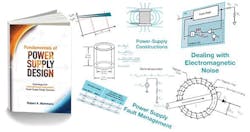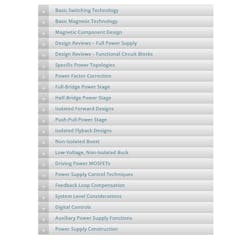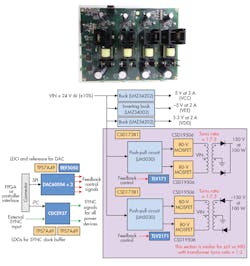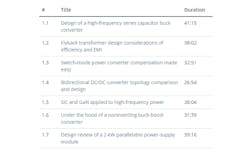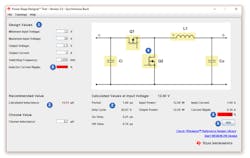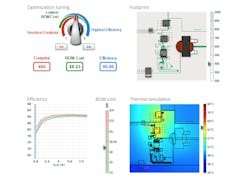Download this article in PDF format.
Back when Yoda was a Jedi-in-training, designing a power supply was relatively straightforward. We lived in a linear world: The front end of a typical power supply consisted of a transformer feeding a full-wave bridge rectifier followed by a large-value filter capacitor.
Incidentally, since Yoda was over 900 years old when this picture was taken (Fig. 1), the rectifier might have used vacuum-tube technology. But we digress.
1. “A difficult path it will be. Master many skills you must.” A switching power-supply designer must be familiar with a variety of disciplines, including magnetics, layout, thermal management, and digital control. (Source: Lucasfilm)
As described, a linear design is simple, reliable, and if an unregulated power supply meets your requirements, efficient, too. Add regulation, though, and the efficiency plummets. Linear regulators, as is well-known, control the output voltage by dropping it across the pass element (the power transistor), which dissipates copious amounts of heat and results in an efficiency as low as 60%.
Switching power topologies changed all that. Chopping up the incoming dc voltage into a high-frequency switched voltage and using that to produce the desired output voltage and current allows the power transistors to spend most of their time in the efficient “on” or “off” states, minimizing power losses.
A switching power supply can be designed in a number of ways. Over time, new switching topologies spread like weeds, each one with advantages and drawbacks. The list of available options now includes the boost, buck, buck-boost, Cuk, flyback, forward, full-bridge, half-bridge, push-pull, SEPIC, synchronous buck, two-switch forward, Weinberg, and zeta topologies.
There also has been a proliferation of power devices. Bipolar transistors have largely been replaced by a variety of MOSFET technologies, and silicon has been joined by silicon carbide (SiC) and gallium nitride (GaN).
Switching power supplies today operate at frequencies in the megahertz range and can achieve efficiencies of over 90%. Unfortunately, this increased performance has raised the bar considerably for the designer, who now must be conversant in a wide range of techniques: high-frequency magnetics, thermal management, electromagnetic compatibility (EMC), switching transistor technology, printed circuit board layout, digital and analog control theory, plus others.
One-Stop Shopping for Power Education Resources
Major suppliers of power-supply components, such as Texas Instruments, have long recognized the increasing complexity of switching power-supply designs. On that front, TI continues to expand its array of online and offline tools that both simplify the design process and provide continuing education for new and old power-supply engineers alike.
Over the years, there has been a wave of consolidations in the semiconductor industry. Many storied names in analog and power (Burr-Brown, National Semiconductor, Power Trends, and Unitrode, for example) are now part of the TI family, so their extensive collections of application notes, white papers, and training material are now available in one place.
In this article, we’ll examine the many TI resources available to help you master the basics of power-supply design, hone your existing skills, learn about the latest technology, or get help with your application.
Books and Other Resources
2. "The Fundamentals of Power Supply Design" is a comprehensive introduction to the state of the art. (Source: TI Power House blog)
As we’ve seen, power-supply design is a constantly changing field. TI’s new book, The Fundamentals of Power Supply Design, should be the latest addition to your library (Fig. 2). It’s the work of Bob Mammano—inventor of the first switched-mode power-supply control integrated circuit and a power electronics pioneer with over 40 years of industry experience—helped by contributions from other TI experts.
The book, which begins with the history of power plus an introduction to power-supply basics, progresses to topics such as topology selection, magnetics design, and power-supply construction. All topics are well-supported by theories, equations, and measurements, as well as supplemented with detailed and colorful charts, graphs, and diagrams.
Although The Fundamentals of Power Supply Design is the latest offering, TI’s website also contains links to other resources in pdf format, free to download.
Power Topologies Handbook: This 199-page book (2017) by Markus Zehender and Matthias Ulmann begins by discussing fundamental power-supply terminology and the general equations for calculating RMS and ac currents. It then reviews the schematics and relevant calculations for 16 different converter topologies, ranging from the well-known buck and flyback designs to more obscure types such as the Zeta, Cuk, and Weinberg converters.
Power Topologies Quick Reference Guide: A concise summary (9 pages) of key topologies, waveforms, and equations.
Power Seminar White Papers: TI has been conducting power design seminars every year or two for over three decades. The collection of material comprises a comprehensive power-supply reference that can help you solve your most complex design challenges. Figure 3 shows the top-level list of topics.
3. The material from 30 years of power seminars is available online. (Source: TI Power Seminar White Papers)
Each topic section contains multiple white papers, presentations, or videos: “Basic Switching Technology,” for example, has 43 entries, covering everything from the fundamentals—e.g., “Switching Power Supply Topology Review”—to the latest technologies—e.g., “SiC and GaN applied to high-frequency power.”
Although older resources may not include the very latest wrinkles in power-supply design, they offer a solid grounding in the fundamentals and new techniques at the time of their introduction.
The Magnetics Design Handbook, for example, dates back to 2001, but provides an excellent introduction to basic magnetic technology and magnetic component design.
Power-Supply Reference Designs
4. Reference designs, such as the 400-W programmable ultrasound power-supply shown here, are a valuable source of practical design tips. (Source: TIDA-01352 PDF)
The portfolios for many products include reference designs that include invaluable practical insights. The design manual for the 400-W ultrasound power supply (Fig. 4), for instance, includes a review of the application (a portable ultrasound scanner), system-level requirements for the power supply, topology selection, and the choice of devices. The manual includes a detailed discussion of the design process, including the determination of baseline parameters, calculation of component values, PCB layout guidelines, available software, test results, thermal performance, and more. It’s 65 pages of pure gold!
The TI website features over 1900 power-supply reference designs for medical, automotive, audio, industrial, telecommunications, Internet of Things (IoT), and other applications.
Video Training
The Power Supply Design Training Series consists of a series of technical training videos with related white papers and a downloadable PDF of the presentation material. Each video in the list of topics (Fig. 5) explores a particular subject in depth with the help of a team of TI experts.
5. If you prefer your training in video form, the Power Supply Design Training series is for you. (Source: TI Power Supply Design Training Series)
Downloadable and Web-Based Tools
Learning the intricacies of power-supply design is one half of the coin. The other half is leveraging an existing knowledge base to help you get to market in the shortest time using one of TI’s downloadable and web-based power-supply design tools.
The Power Stage Designer is a downloadable application that helps you design the power stage of the most commonly used switch-mode topologies. It also helps you gain a deeper understanding of the voltages and current flows. After you choose the desired topology, the screen shown in Figure 6 opens up. The elements are:
- The "Design Values" entry block contains the desired power-supply specifications.
- The program calculates the inductor value and key parameters for the desired inputs.
- Error notifications are highlighted in red. In this case, the desired inductor current ripple is not achievable with the desired inductance value.
- Clicking on a component in yellow opens an interactive window that displays its voltage and current waveforms. The waveforms change with variations in input voltage.
- The Information button displays design tips, circuit information, suggested parts, and links to application notes and white papers.
6. The Power Stage Designer Tool helps designers evaluate the performance of different topologies in their chosen application. (Source: TI Power Management: Power Stage Designer)
The web-based tools are grouped under the WEBENCH name. This online environment consists of online software tools that help engineers generate, optimize, and simulate designs in multiple application areas, including power supplies, amplifiers, sensors, LED control, battery chargers, active filters, and more.
For power designers, WEBENCH includes several tools optimized for different applications:
Single-output supplies
7. WEBENCH Power Designer includes the Optimizer Dial, which allows a design to be optimized for small footprint, high efficiency, or low system BOM cost. (Source: TI Design Tools: WEBENCH Power Designer)
Power Designer is designed for single-output power supplies (Fig. 7). The tool has a four-step flow:
- SELECT: Power Designer begins by displaying a wide range of designs that meet your initial set of requirements. The Optimizer helps sort the list based on your design requirements—smallest footprint, lowest BOM cost, or highest efficiency. You select one device that you would like to explore further.
- DESIGN: Once you have selected a device, Power Designer generates a design and the Dashboard opens up to help you more closely examine the design. The dashboard displays the available tools, and allows you to refine the initial specifications. It also displays performance metrics such as efficiency over the operating range, loop response, and duty-cycle variations.
- ANALYZE: Using the dashboard, the next step is to fully exercise your solution to verify the performance using electrical simulation, thermal simulation, and the schematic editor. With the Compensation Designer, you can quickly design, analyze, and optimize the compensation network, and compare alternatives. The OpVal window displays current operating values and allows you to run a worst-case analysis using corner device values.
- EXPORT: WEBENCH Power Designer provides Schematic Export, PCB export, Simulation export, and complete documentation to help you build and test the prototype design. Using the Build-It tool, you can order a kit of parts or a fully assembled and tested board that meets your design requirements.
Multi-output supplies
Power Architect uses the same four-step approach as Power Designer, but for multi-output supplies. Designers can optimize a complete power-supply system for small footprint, high efficiency, or cost.
Some of the added features for multiple supplies include:
- Enter individual load specifications as well as system specifications.
- Add capabilities such as hot swap, isolation, or multiple sources.
- Pick from a long list of FPGAs, microprocessors, microcontrollers, or DDR memory loads, or specify a custom combination of supplies. Add power-supply sequencing if required.
- Narrow down the options: PMIC/PMUs, modules, Simple Switcher solutions, or automotive-compliant designs.
Battery chargers
The mobile and wearables market has spurred a need for sophisticated charger designs for different battery packs. Battery Charger Designer takes an initial list of requirements, such as the number of cells, their capacity, and current and voltage requirements, and then it uses a similar procedure as other WEBENCH tools to generate and filter candidate designs, perform analysis, and export the results.
Other Resources
For those times when you just need to connect with your colleagues, why not tap into TI’s thriving online community of power-supply designers?
To ask questions, share knowledge, or help fellow engineers solve problems, you can head over to the TI Power Management Forum, which has sections for each sub-specialty: isolated power, linear regulators, voltage references, power MOSFETs, power modules, wireless power, and more.
TI’s power engineers provide the content for the Power House blog that covers just about anything power-related: design tips, new products, power-supply fundamentals, and more.
Conclusion: The Truth Help Is Out There
Over the last several decades, power-supply performance has improved dramatically. Designs have progressed from simple, but inefficient, linear designs to a bewildering array of switched-mode topologies.
The proliferation of designs has raised the bar for power-supply design engineers, who must not only keep up with the new technologies, but also produce new designs quickly that satisfy efficiency, cost, and size requirements.
The range of educational and design tools discussed here goes a long way to help meet those goals.
By the way, anyone have a schematic for that super-laser power supply on the Death Star? Just wondering which TI parts it uses….


